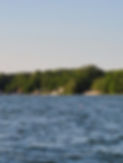


Milfoil Found in Otsego Lake - 2018
The OLA Board has been obtaining weed surveys in our lake for many years. In Fall 2018, the survey results reveal the possibility of Eurasian milfoil. The specimens collected had already began to undergo degradation, therefore, the identification was less than ideal but they did appear to be consistent with Eurasian milfoil. It is possible that this is a native species of milfoil, which is not invasive and has been found in Otsego Lake in the past. It is not necessary to treat native milfoil, but it is important to identify and treat Eurasian milfoil since it is invasive. We will be doing a follow-up survey this summer with firm PLM. The most common way that these invasive weeds get into Otsego is by any watercraft visiting other lakes and bringing the weeds in by failing to adequately follow procedures for cleaning boats prior to launching. Please adopt these procedures and encourage use amongst family and friends. They are clearly posted at major launch sites. We will keep you posted regarding the follow-up surveys as soon as they are available.
Help Stop Cyanobacteria in Otsego Lake
By: Laura Justin, Guest columnist
Being new to Otsego Lake, my husband and I still have a lot to discover and enjoy as we explore the beautiful waters. We have a home on the canal at the northeast tip of the lake and love all of the wildlife and beauty that surrounds us. I also happen to be the Executive Director of HeadWaters Land Conservancy in Gaylord and wrote our fall 2018 newsletter editorial about the joy of living on the lake.
Unfortunately, there is also some bad news to share. This past September brought an unwelcome guest to the canal in the form of blue-green algae, which is more correctly identified as cyanobacteria. I noticed what looked like a thick stream of blue paint coming into the canal from the lake, which assimilated and clouded all the water over the coming days. These microscopic organisms are naturally present in lakes and streams but under certain conditions, blue-green algae can become over-abundant in warm, shallow, nutrient-rich (often caused by fertilizer run-off) surface waters. When this occurs, blue-green algae can form blooms that discolor the water, or produce floating mats or scums on the water’s surface. Cyanobacteria can turn the water blue-green, green, yellow, white, brown, purple, or red and has a paint-like appearance.
Our neighbor reported the cyanobacteria to the DEQ right away and they tested the water because it can be very dangerous to you AND your pets! Health problems can include diarrhea, nausea, or vomiting; skin, eye, or throat irritation; and allergic reactions or breathing difficulties. Exposures can occur while swimming, wading, fishing, or boating in areas with blue-green algae blooms. Exposures can occur by swallowing water, contact with the skin, eating fish caught from affected areas, and when airborne droplets are inhaled. Luckily, this is the first ever report made to the DEQ about blue-green algae in the lake. The blooms generally last for a brief period of time and then dissipate, but warmer summers will lead to longer blooms. Unfortunately, blue-green algae blooms won’t disappear overnight and there is no treatment that will kill them.


What Can We Do?
The most important and effective thing we can all do is STOP USING FERTILIZER! Fertilizer provides the nutrition cyanobacteria thrives on in the form of nitrogen and phosphorous. Once these nutrients are in a lake, it can take years for their levels to be reduced. PLEASE help keep Otsego Lake beautiful by ELIMINATING fertilizer use on your lawn!
Learn more by visiting the official "Michigan Clean Boats, Clean Waters" Facebook page: https://www.facebook.com/MichiganCBCW
